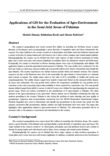Applications of GIS for the Evaluation of Agro-Environment in the Semi-Arid Areas of Pakistan
JIRCAS international symposium series
| ISSN | 13406108 |
|---|---|
| 書誌レコードID(総合目録DB) | AA1100908X |

本文フルテキスト
intlsymp-8_85-100.pdf1.2 MB
The country's geographical area covers around 88.2 million ha including the Northern Areas. A great diversity of bio-climates and correspondingly a great diversity of vegetation types and fauna characterize the country. The major habitats in the country consist of a) flood plains, arid plains, sand and piedmont deserts and a variety of forests; b) grassy tundra and cold deserts; and c) lakes, rivers, swamps, and coastal marine habitats. Physiographically, the country can be divided into three main regions: a) high northern mountains; b) Indus plain; and c) lower and more arid western highlands. In addition, there are piedmonts, deserts and delta areas. Ecologically, the country is described as diverse showing almost every type of physiography and climate. GIS application helped to describe agricultural environments in Pakistan. Two case studies were conducted. For the first case study, as a first step, seasonal aridity and crop growth indices were used to characterize and classify the agro-climates. The country experiences two distinct seasons namely winter and summer seasons. The summer season is wet due to the Monsoon rains. Due to the seasonality, the agro-climate is characterized on a seasonal basis instead of annual. The aridity index refers to the ratio of 50 % probability of rainfall and actual crop evapotranspiration. The aridity classes ranged from humid to hyper-arid. Based on the seasonal aridity classes, 18 zones were delineated. The crop growth index reflects the temperature availability for crop growth and is estimated, as the ratio of growing degree-days available to those required by a particular crop. The crop growth classes defined ranged from deficit to excess. A total of 9 zones were defined by superimposing the seasonal crop growth maps. These two indices contributed to the classification of 57 agro-climates in Pakistan. The other element of the agro-environment is the agro-relief. Various classes can be identified considering the land use systems prevailing in the country. Pakistan is also facing the problem of water shortage and poor quality of groundwater. Long-term data of groundwater monitoring from the MONA Reclamation Experimental Project, Bhalwal, Sargodha were used to characterize and classify the groundwater in the second case study. For this purpose, parameters like groundwater, salinity, sodicity and high bicarbonate level were used. The paper also highlights other applications related to agro-environments in Pakistan. The information generated will be of immense value to the planners, researchers and educationists in the country.
| 作成者 | Shahid Ahmad Rakhshan Roohi Akram Kahlown |
|---|---|
| 公開者 | Japan International Research Center for Agricultural Sciences |
| オンライン掲載日 | |
| 号 | 8 |
| 開始ページ | 85 |
| 終了ページ | 100 |
| 言語 | eng |
